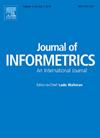通过分析一篇论文如何使后继论文黯然失色来量化它的破坏性
IF 3.5
2区 管理学
Q2 COMPUTER SCIENCE, INTERDISCIPLINARY APPLICATIONS
引用次数: 0
摘要
Funk和Owen-Smith(2017)提出的颠覆指数(DI)是一个实用的指标,已被广泛用于识别和分析颠覆性研究。然而,该方法存在易受作者操纵、对局部引文网络的关注过于狭隘、收敛性不合理等局限性。为了解决这些缺点,我们提出了一种新的遮蔽干扰指数(∆DI),以DI为基础,通过考察焦点论文对后续论文的遮蔽影响来捕捉其破坏性。以359篇高被引论文、443篇中等被引论文和40篇诺贝尔物理学奖获奖论文为研究对象,利用统计学方法和GPT-4分析了∆DI的演化轨迹,并论证了其合理性。具体来说,∆DI呈现出收敛于零的衰减趋势,表明论文的破坏性影响随着时间的推移而下降。通过GPT-4分析论文的研究内容,我们进一步从语义分析的角度解释这种衰减趋势。此外,我们全面检查了∆DI的统计数据,并揭示了它与基于DI的常见指标的相关性。最后,我们通过仔细研究∆DI与未来科学影响之间的关系,系统地验证了∆DI的有效性。结果表明,∆DI比DI和DI5具有更好的预测能力,并且ΔDI和DI的组合在预测科学影响方面效果最好。本文章由计算机程序翻译,如有差异,请以英文原文为准。
Quantifying the disruptiveness of a paper by analyzing how it overshadows its successors
The disruption index (DI) proposed by Funk and Owen-Smith (2017) is a practical metric that has been widely used to identify and analyze disruptive research. However, it suffers from several limitations, such as susceptibility to authors’ manipulation, a narrow focus on the local citation network, and unreasonable convergence characteristics. To address these shortcomings, we propose a novel overshadowing disruption index (∆DI), based on the DI, that captures the disruptive quality of a focal paper by examining its overshadowing impact on its successors. Using 359 highly cited, 443 moderately cited, and 40 Nobel Prize-winning physics papers as research objects, we analyze the evolutionary trajectories of ∆DI and demonstrate its rationality via the statistical methods and GPT-4. Specifically, ∆DI presents a decay trend converging to zero, indicating that the disruptive impact of a paper declines over time. By analyzing papers’ research content via GPT-4, we further explain the decay trend from the perspective of semantic analysis. Additionally, we comprehensively examine ∆DI’s statistics and unveil its correlation with common DI-based metrics. Finally, we systematically verify the effectiveness of ∆DI by scrutinizing the relationship between ∆DI and future scientific impact. Our results show that ∆DI exhibits better predictive power than DI and DI5, and the combination of ΔDI and DI performs the best in predicting scientific impact.
求助全文
通过发布文献求助,成功后即可免费获取论文全文。
去求助
来源期刊

Journal of Informetrics
Social Sciences-Library and Information Sciences
CiteScore
6.40
自引率
16.20%
发文量
95
期刊介绍:
Journal of Informetrics (JOI) publishes rigorous high-quality research on quantitative aspects of information science. The main focus of the journal is on topics in bibliometrics, scientometrics, webometrics, patentometrics, altmetrics and research evaluation. Contributions studying informetric problems using methods from other quantitative fields, such as mathematics, statistics, computer science, economics and econometrics, and network science, are especially encouraged. JOI publishes both theoretical and empirical work. In general, case studies, for instance a bibliometric analysis focusing on a specific research field or a specific country, are not considered suitable for publication in JOI, unless they contain innovative methodological elements.
 求助内容:
求助内容: 应助结果提醒方式:
应助结果提醒方式:


